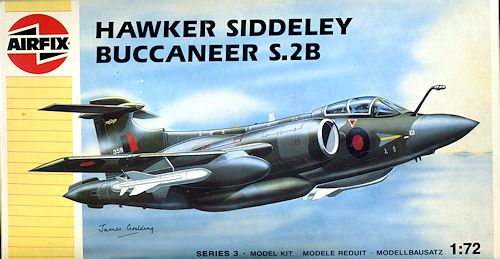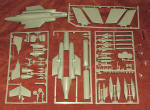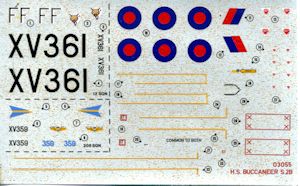
Airfix 1/72 Buccaneer S.2B
| KIT #: | 03055 |
| PRICE: | $Do not recall |
| DECALS: | Two options |
| REVIEWER: | Scott Van Aken |
| NOTES: | 1989 boxing |

| HISTORY |
The Blackburn Buccaneer was a British low-level subsonic strike aircraft that served with the Royal Navy (RN) and later the Royal Air Force (RAF), retiring from service in 1994. Designed and initially produced by Blackburn Aircraft at Brough, it was later known as the Hawker Siddeley Buccaneer when Blackburn became a part of the Hawker Siddeley group.
The Royal Navy originally procured the Buccaneer as a naval strike aircraft capable of operating from their aircraft carriers, introducing the type to service in 1962 to counterbalance advances made in the Soviet Navy. The Buccaneer was capable of delivering nuclear weapons as well as conventional munitions for anti-shipping warfare, and were typically active in the North Sea area during its service. Early on the initial production aircraft suffered a series of accidents due to insufficient engine power, thus the Buccaneer S.2, equipped with more powerful Rolls-Royce Spey engines, was soon introduced.
Although they originally rejected it in favour of the supersonic BAC TSR-2, the RAF later procured the Buccaneer as a substitute following the cancellation of both the TSR-2 and its planned replacement, the F-111K. When the RN retired the last of its large aircraft carriers, its Buccaneers were transferred to the RAF. The South African Air Force also procured the type. Buccaneers saw combat action in the Gulf War and the South African Border War. In RN service, the Buccaneer was replaced with the V/STOL British Aerospace Sea Harrier. In RAF service, they were replaced by the Panavia Tornado.
| THE KIT |
 Airfix's initial foray into Buccaneers was back in the 60s when they did the S.1 variant with the small intakes. It was, as were all Airfix kits of the day, a pretty crude affair and while I am sure many were pleased with it at the time, it was not something that most would want to deal with today. It seems to me that the kit was upgraded to S.2 levels, but I'm not positive on that. In the late 1980s, the kit was either retooled or a new one was developed and that is this boxing.
Airfix's initial foray into Buccaneers was back in the 60s when they did the S.1 variant with the small intakes. It was, as were all Airfix kits of the day, a pretty crude affair and while I am sure many were pleased with it at the time, it was not something that most would want to deal with today. It seems to me that the kit was upgraded to S.2 levels, but I'm not positive on that. In the late 1980s, the kit was either retooled or a new one was developed and that is this boxing.
The kit still contains the raised panel lines we have all come to expect from older Airfix kits. There was also some flash and a few bits had sink areas, but overall, it is a major improvement over the initial issue. It is also an improvement in some regards to the Matchbox kit, which had been out for many years before this one saw production.
The kit's interior is pretty basic with a tub into which a pair of seats, a sight and a rear instrument panel are fitted. There are two crew figures and while console shapes are molded into the tub, there is no instrument panel or console detail nor are there even decals. Compressor faces are molded into a blanking plate that fits into the lower fuselage half. Removing the intake seams will be a challenge. The kit can also be built as an S.2 with the flat bomb bay, though no markings are provided for that version. The instructions recommend 5 grams of nose weight and there is room for it.
The wings are molded in the extended position with the slightly longer wing tips. The nose cone is separate and according to those who know, it and the tailplane are a bit off in shape. The speed brake is two halves, but unlike the earlier kit, can only be molded closed. Landing gear, both main and nose, have the wheels molded in place. Gear well detail is minimal.
This kit does have plenty of things to put under wings included fuel tanks, a data link pod, Martel and Sea Eagle missiles. From what I have read, the pylons are the wrong shape, but there have been aftermarket bits for that. The kkit also includes chaff/flare dispensers for the underside of the fuselage plus the usual plethora of antennas an a refueling pod. The clear bits consist of a separate windscreen and canopy as well as a blast shield for the backseater.
 Instructions are well done with the usual 'Humbrol only' paint numbers and no description of what they are. Two planes are provided, both in the grey/green wraparound scheme. Both have bare metal leading edges to the wings and tailplanes. One is with 208 Squadron in 1988 while the other is 12 Squadron in 1985. Load out information is provided, which is a nice touch. The decals are nicely printed, but over the years have become quite spotted and so their usefulness is in question. It contains a full data suite. There have been plenty of aftermarket options from Modeldecal and others over the years, so finding a scheme should not be an issue.
Instructions are well done with the usual 'Humbrol only' paint numbers and no description of what they are. Two planes are provided, both in the grey/green wraparound scheme. Both have bare metal leading edges to the wings and tailplanes. One is with 208 Squadron in 1988 while the other is 12 Squadron in 1985. Load out information is provided, which is a nice touch. The decals are nicely printed, but over the years have become quite spotted and so their usefulness is in question. It contains a full data suite. There have been plenty of aftermarket options from Modeldecal and others over the years, so finding a scheme should not be an issue.
| CONCLUSIONS |
I do not know if the Buccaneer is on Hornby's redo list, but I'd be surprised were it not. It is a neat plane and despite a rather limited number of camo and markings options, is a brutish looking plane that deserves to be on your shelf.
| REFERENCES |
http://en.wikipedia.org/wiki/Blackburn_Buccaneer
2013 Thanks to your editor for the preview kit. If you would like your product reviewed fairly and fairly quickly, please contactthe editor or see other details in the